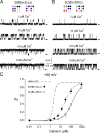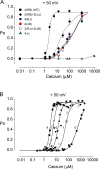Intra- and intersubunit cooperativity in activation of BK channels by Ca2+
- PMID: 17001085
- PMCID: PMC2151572
- DOI: 10.1085/jgp.200609486
Intra- and intersubunit cooperativity in activation of BK channels by Ca2+
Abstract
The activation of BK channels by Ca(2+) is highly cooperative, with small changes in intracellular Ca(2+) concentration having large effects on open probability (Po). Here we examine the mechanism of cooperative activation of BK channels by Ca(2+). Each of the four subunits of BK channels has a large intracellular COOH terminus with two different high-affinity Ca(2+) sensors: an RCK1 sensor (D362/D367) located on the RCK1 (regulator of conductance of K(+)) domain and a Ca-bowl sensor located on or after the RCK2 domain. To determine interactions among these Ca(2+) sensors, we examine channels with eight different configurations of functional high-affinity Ca(2+) sensors on the four subunits. We find that the RCK1 sensor and Ca bowl contribute about equally to Ca(2+) activation of the channel when there is only one high-affinity Ca(2+) sensor per subunit. We also find that an RCK1 sensor and a Ca bowl on the same subunit are much more effective in increasing Po than when they are on different subunits, indicating positive intrasubunit cooperativity. If it is assumed that BK channels have a gating ring similar to MthK channels with alternating RCK1 and RCK2 domains and that the Ca(2+) sensors act at the flexible (rather than fixed) interfaces between RCK domains, then a comparison of the distribution of Ca(2+) sensors with the observed responses suggest that the interface between RCK1 and RCK2 domains on the same subunit is flexible. On this basis, intrasubunit cooperativity arises because two high-affinity Ca(2+) sensors acting across a flexible interface are more effective in opening the channel than when acting at separate interfaces. An allosteric model incorporating intrasubunit cooperativity nested within intersubunit cooperativity could approximate the Po vs. Ca(2+) response for eight possible subunit configurations of the high-affinity Ca(2+) sensors as well as for three additional configurations from a previous study.
Figures






Comment in
-
A tail of multiple calcium-sensing domains.J Gen Physiol. 2006 Oct;128(4):387-8. doi: 10.1085/jgp.200609536. J Gen Physiol. 2006. PMID: 17001084 Free PMC article. No abstract available.
Similar articles
-
The NH2 terminus of RCK1 domain regulates Ca2+-dependent BK(Ca) channel gating.J Gen Physiol. 2005 Sep;126(3):227-41. doi: 10.1085/jgp.200509321. Epub 2005 Aug 15. J Gen Physiol. 2005. PMID: 16103277 Free PMC article.
-
Interactions of divalent cations with calcium binding sites of BK channels reveal independent motions within the gating ring.Proc Natl Acad Sci U S A. 2016 Dec 6;113(49):14055-14060. doi: 10.1073/pnas.1611415113. Epub 2016 Nov 21. Proc Natl Acad Sci U S A. 2016. PMID: 27872281 Free PMC article.
-
Molecular determinants of Ca2+ sensitivity at the intersubunit interface of the BK channel gating ring.Sci Rep. 2018 Jan 11;8(1):509. doi: 10.1038/s41598-017-19029-8. Sci Rep. 2018. PMID: 29323236 Free PMC article.
-
Large conductance Ca2+-activated K+ (BK) channel: activation by Ca2+ and voltage.Biol Res. 2006;39(3):385-401. doi: 10.4067/s0716-97602006000300003. Epub 2006 Nov 7. Biol Res. 2006. PMID: 17106573 Review.
-
Modulation of BK Channel Function by Auxiliary Beta and Gamma Subunits.Int Rev Neurobiol. 2016;128:51-90. doi: 10.1016/bs.irn.2016.03.015. Epub 2016 Apr 8. Int Rev Neurobiol. 2016. PMID: 27238261 Free PMC article. Review.
Cited by
-
Effects of aerobic exercise training on large-conductance Ca(2+)-activated K (+) channels in rat cerebral artery smooth muscle cells.Eur J Appl Physiol. 2013 Oct;113(10):2553-63. doi: 10.1007/s00421-013-2695-7. Epub 2013 Jul 17. Eur J Appl Physiol. 2013. PMID: 23860842
-
Modulation of the conductance-voltage relationship of the BK(Ca) channel by shortening the cytosolic loop connecting two RCK domains.Biophys J. 2009 Aug 5;97(3):730-7. doi: 10.1016/j.bpj.2009.04.058. Biophys J. 2009. PMID: 19651031 Free PMC article.
-
A linkage analysis toolkit for studying allosteric networks in ion channels.J Gen Physiol. 2013 Jan;141(1):29-60. doi: 10.1085/jgp.201210859. Epub 2012 Dec 17. J Gen Physiol. 2013. PMID: 23250867 Free PMC article.
-
The allosteric gating mechanism of the MthK channel.Natl Sci Rev. 2022 Apr 13;9(8):nwac072. doi: 10.1093/nsr/nwac072. eCollection 2022 Aug. Natl Sci Rev. 2022. PMID: 36072506 Free PMC article.
-
Cryo-EM structure of the open high-conductance Ca2+-activated K+ channel.Nature. 2017 Jan 5;541(7635):46-51. doi: 10.1038/nature20608. Epub 2016 Dec 14. Nature. 2017. PMID: 27974795 Free PMC article.
References
-
- Adelman, J.P., K.Z. Shen, M.P. Kavanaugh, R.A. Warren, Y.N. Wu, A. Lagrutta, C.T. Bond, and R.A. North. 1992. Calcium-activated potassium channels expressed from cloned complementary DNAs. Neuron. 9:209–216. - PubMed
-
- Atkinson, N.S., G.A. Robertson, and B. Ganetzky. 1991. A component of calcium-activated potassium channels encoded by the Drosophila slo locus. Science. 253:551–555. - PubMed
Publication types
MeSH terms
Substances
Grants and funding
LinkOut - more resources
Full Text Sources
Miscellaneous

